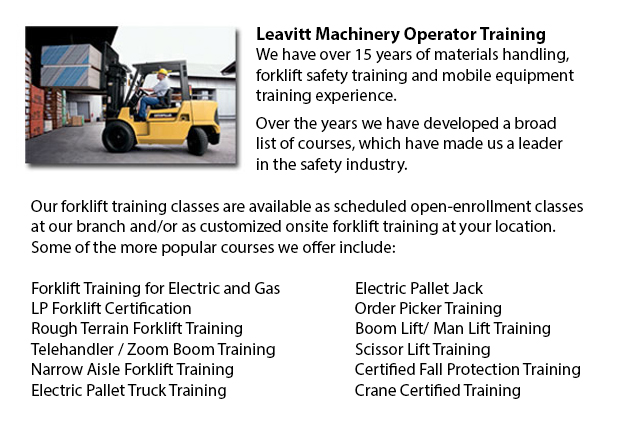
Vernon Forklift Training Schools - Forklift Training Schools - For The Wellbeing Of Your Workers
Are you looking for a job as a forklift driver? Our regulatory-compliant mobile equipment operator training offers instruction in types of lift trucks, pre-shift check, fuel kinds and handling of fuels, and safe utilization of a lift truck. Practical, hands-on training assists participants in obtaining basic operational skills. Program content covers existing rules governing the operation of forklifts. Our proven forklift courses are intended to offer training on these kinds of trucks: powered pallet truck, narrow isle forklift and counterbalanced forklift.
While the lift truck is in operation, do not raise or lower the forks. Loads must not extend above the backrest. This is because of the risk of the load sliding back in the direction of the operator. Inspect for overhead obstacles and make certain there is adequate clearance before raising a load. Stay away from overhead power lines. When the load is raised straight up, tilt it back slightly.
The lift truck is less steady when a load is in a raised position. Make certain that no one ever walks below the elevated fork. The operator must never leave the lift truck when the load is lifted.
The forks should be level when handling pallets, and high enough to extend all the way into and beneath the load. The width of the forks should provide even distribution of weight.
Prior to unloading or loading the truck, chock the wheels and set the brakes. Floors have to be strong enough to support the weight of the forklift and the load combined. Fixed jacks can be installed in order to support a semi-trailer that is not coupled to a tractor. The height of the entrance door should clear the forklift height by at least 5 cm. Mark edges of rail cars, ramps or docks and avoid them.
-
Vernon Heavy Equipment Training Programs
Vernon Heavy Equipment Training Programs - At whatever given construction site, there are often different types of machinery which are ready to be used. These heavy and light machines need both operators to run them and mechanics to fix them. Trainee... More -
Vernon Forklift Safety Training
Vernon Forklift Safety Training - People wanting work in industries that operate lift trucks should undergo a forklift safety training program before becoming a certified operator of a lift truck. There are a lot of ways to go about acquiring forklif... More -
Vernon Aerial Boom Lift Ticket
Vernon Aerial Boom Lift Ticket - Aerial platform lifts can accommodate various odd jobs involving high and tough reaching places. Normally used to complete regular preservation in structures with tall ceilings, prune tree branches, elevate heavy shel... More -
Vernon Manlift Safety Training
Vernon Manlift Safety Training - Manlift operators need to be cognizant and aware of all the potential dangers which are associated with particular classes of scissor lifts. They need to be able to operate the scissor lift in a way that protects not... More -
Vernon Forklift License
Vernon Forklift License - Obtaining a forklift certification or forklift license in North America will require the one training to carry out hands-on training in addition to classroom instruction. The provincial, federal and state regulatory bodies a... More -
Narrow Aisle Forklift, Order Picker, Electric Pallet Jack, Electric Pallet Truck Certification in Vernon
A pallet lift is a model of equipment dedicated in the transporting of pallets of many dimensions and weights. They can be utilized as an appendage for forklifts, cranes and other styles of heavy machinery or be applied on their own. Pallet hoists ar... More -
Vernon Boom Lift Safety Training
Vernon Boom Lift Safey Training - Boom lifts are a type of elevated work platform or aerial lifting device which are commonly utilized in construction, industry, and warehousing. Boom lifts can be utilized in practically any surroundings because of t... More -
Vernon Manlift Operator Training
Vernon Manlift Operator Training - The aerial lift or manlift is a specialized kind of hydraulic platform that is designed to lift a person vertically giving it an alternate name of a vertical personnel lift. These machinery are widely utilized for a... More

Forklift Certification Vernon
TOLL FREE: 1-888-254-6157
Vernon, British Columbia
forkliftcertificationvernon.com
Email Us
About Us


